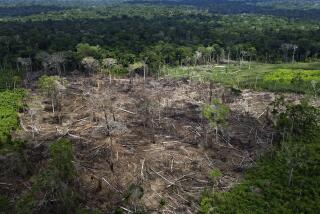The Forests Were the First Casualty: Scientist Tries to ‘Green’ Vietnam : Environment: A barren wasteland continues to grow in the face of population pressure and logging activities.
- Share via
GENEVA — Fifteen years after the end of the Vietnam War, which left parts of that country a wasteland, a 60-year-old Vietnamese ornithologist is fighting to revive the lush forests of his homeland.
Professor Vo Quy is campaigning at home and abroad for resources to help reclaim vast tracts of devastated forest and fields. It’s an uphill struggle because more forest continues to be destroyed each year than is replanted, despite his tireless efforts.
But Vo is confident that he and nature will win.
“I’m very optimistic,” he said during a trip to Geneva to drum up support. “I would like in the very near future for half of our country to be covered in forest again.”
In the early 1940s--before fighting, first against French colonial control, then against the United States, which continued until April 30, 1975--paralyzed the country, 46% of Vietnam’s 83 million acres was forest.
That fell to 29% in 1975 and has dropped further under population pressure and logging activities to only about 20% now.
An astounding two-fifths of the country is just barren wasteland, Vo said.
Although other factors have played their part in the destruction, much of it was caused by heavy bombing and the U.S. use of the defoliant Agent Orange during the war.
U.S. troops sprayed the chemical on infiltration routes, such as the Ho Chi Minh Trail, and large areas of forest from which Viet Cong and North Vietnamese soldiers launched assaults.
Elizabeth Kemf, an environmentalist at the World Wide Fund for Nature who has worked with Vo and visited Vietnam several times in the ast few years to survey the damage, said the poisoned forests are still wastelands, unable to recover.
Kemf described what she found in Vietnam in her just-published book, “Month of Pure Light: The Regreening of Vietnam.”
“On both sides of the valley the hills were stripped bare, their ridges lined with the fragmented trunks of dead trees. They jutted upon the horizons like the decaying masts of rotting ships,” she wrote.
Huge American bulldozers also cleared broad swathes of forests along roads and canals--a total area of about 800,000 acres--to minimize guerrilla attacks.
Vietnam is pocked with 25 million bomb craters. Some have been turned into fish ponds or vegetable patches, but water often drains into them, making them unusable for normal agriculture.
Vo had his first vision of what needed to be done when he sneaked south across the Demilitarized Zone dividing North Vietnam from South Vietnam during fighting in the early 1970s.
Appalled by what he saw, he immediately started planning to repair the damage.
“I dreamed, ‘We can recover this,’ and I have pursued this dream until now,” the Chinese-educated ornithologist said.
He drafted Vietnam’s National Conservation Strategy, encouraging the replanting of entire forests. He also visited village chiefs to discourage further destruction.
“He awakened them to the fact that there is an environmental crisis,” Kemf said.
In 1988 the World Wide Fund for Nature awarded Vo its annual Gold Medal for his work.
Until recently a half a million acres of forest were being lost each year, while only half that area was being replanted.
Under Vo’s guidance the area being reforested each year has painstakingly been increased to 375,000 acres. He said he hopes eventually to increase that figure to 750,000 acres.
But it is very expensive to reclaim the inhospitable land, some of it now rock-hard, some still covered with wreckage from the war, some smothered with tall grass that is too tough for livestock and difficult to remove.
It is particularly hard for an impoverished country like Vietnam.
Vo insists that environmental problems affect the entire world and urges governments and private groups alike to help the restoration process.
“Environmental protection doesn’t benefit this country (Vietnam) alone. It benefits all countries,” he said.
More to Read
Sign up for Essential California
The most important California stories and recommendations in your inbox every morning.
You may occasionally receive promotional content from the Los Angeles Times.









